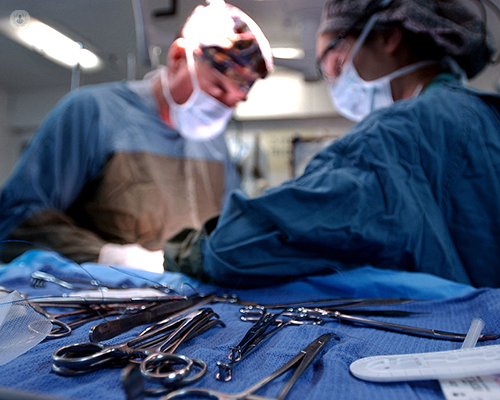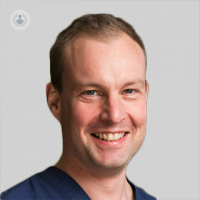The benefits of performing awake brain tumour operations
Written by:Historically, patients were put to sleep for operations as this was the only way that their pain could be controlled throughout the procedure. With newer pain medication, however, it is perfectly possible to operate with patients awake and many hip and knee replacements are done this way in the UK each year. Keeping a patient awake during surgery is safer, as it avoids the risks of a general anaesthetic. With advances of technology, some neurosurgeons now carry out brain tumour surgery with their patient awake. To tell us more about this surgical approach, known as awake craniotomy, we hear from revered consultant neurosurgeon Mr Edward McKintosh.

Why do surgeons operate on the brain with patients awake?
Most brain surgery is done with patients asleep, partly for historical reasons and partly because many patients don’t like the idea of someone operating on their brain while they are awake, and not unreasonably!
Keeping a patient awake during a brain operation allows the surgeon to test the function of the brain repeatedly during the operation in order to avoid any possible brain damage. For many operations on the brain this is not necessary; the risks of modern general anaesthetics are very low and many problems within the brain do not involve surgery near areas which are likely to cause a loss of function.
However, there are a small group of conditions within the brain (mainly brain tumours) where it is necessary to do surgery near parts of the brain which control the arms and legs, or which control speech. In these cases the surgeon will often suggest that the patient consider an awake craniotomy.
What happens during an awake craniotomy?
There are three stages to any brain operation: opening the scalp and skull to expose the brain (the ‘craniotomy’), operating on the brain itself and finally closing the skull and skin.
In awake craniotomies, the middle stage of the operation is done with the patient awake. Individual surgeons and anaesthetists have different practices but leading neurosurgeons may recommend doing the first and last stages of brain tumour surgery with the patient asleep. This way the patient doesn’t experience anything other than when their limb power or speech is being tested. Since the brain itself doesn’t feel touch or pain, they don’t feel the brain tumour being removed.
A therapist is present during the operation to test brain functions; either a physiotherapist if it is limb function being tested, or a speech and language therapist if it is speech function being tested. The testing is done with a weak electrical current applied to ‘stun’ each area of the brain before it is removed, thus confirming whether removing the area would damage function before doing so. There is therefore an electrophysiologist (a consultant doctor specialising in electrical testing of the brain) and their technician present, as well as theatre nurses and an anaesthetic team.
A nurse is asked to act as the patient’s advocate and be available to help the patient with any discomfort such as itches or yawns. It is not a problem for patients to move slightly, cough, or yawn during a brain tumour operation as long as they tell the neurosurgeon beforehand.
Once the brain tumour is removed the patient can be put back to sleep, to be woken up in recovery once the operation is finished.
Although patients often don’t believe it, it is possible to make being awake during brain tumour surgery a very comfortable experience, and most patients are reassured by the feeling that they are very much in control of the operation. The proof of this is that patients almost never choose to be put back to sleep.
What do patients find uncomfortable during an awake craniotomy?
The thing that patients generally complain about during awake brain surgery most is having to stay starved during the operation, for the bits that involve a general anaesthetic. Some patients also feel thirsty and may be given moistened foam ‘lollipops’ or ice cubes to suck on.
Their head is held stationary in a clamp. This is put on when the patient is asleep and doesn’t hurt once in place. With longer brain operations the local anaesthetic can start to wear off, sometimes causing an ache in the forehead, which is treated by giving more local anaesthetic.
As the operation is done with patients on their side, sometimes the shoulder they are lying on starts to ache towards the end of the operation. If the ache becomes unbearable, the patient can be put back to sleep.
What is recovery like after awake brain surgery?
As patients have been awake for most of the operation, they have had much less anaesthetic given to them than other neurosurgery patients. For this reason they actually recover faster after awake brain surgery.
Additionally, operations on the brain are less painful than chest and abdominal operations, in which patients have muscle pain every time they cough and move. Most patients go home two or three days after an awake craniotomy and feel tired for about two weeks before slowly returning to normality within four to six weeks after surgery.



